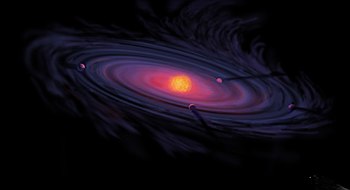Solar System formation
See also: Planetary differentiation
The standard model for the formation of the Solar System (including the Earth) is the solar nebula hypothesis. In this model, the Solar System formed from a large, rotating cloud of interstellar dust and gas called the solar nebula. It was composed of hydrogen and heliumcreated shortly after the Big Bang13.8 Ga (billion years ago) and heavier elements ejected by supernovae. About 4.5 Ga, the nebula began a contraction that may have been triggered by the shock wave from a nearby supernova.A shock wave would have also made the nebula rotate. As the cloud began to accelerate, its angular momentum, gravity, and inertia flattened it into a protoplanetary disk perpendicular to its axis of rotation. Small perturbations due to collisions and the angular momentum of other large debris created the means by which kilometer-sized protoplanetsbegan to form, orbiting the nebular center.
The center of the nebula, not having much angular momentum, collapsed rapidly, the compression heating it until nuclear fusion of hydrogen into helium began. After more contraction, a T Tauri star ignited and evolved into the Sun. Meanwhile, in the outer part of the nebula gravity caused matter to condense around density perturbations and dust particles, and the rest of the protoplanetary disk began separating into rings. In a process known as runaway accretion, successively larger fragments of dust and debris clumped together to form planets. Earth formed in this manner about 4.54 billion years ago (with an uncertainty of 1%) and was largely completed within 10–20 million years.The solar wind of the newly formed T Tauri star cleared out most of the material in the disk that had not already condensed into larger bodies. The same process is expected to produce accretion disks around virtually all newly forming stars in the universe, some of which yield planets.
The proto-Earth grew by accretion until its interior was hot enough to melt the heavy, siderophile metals. Having higher densities than the silicates, these metals sank. This so-called iron catastrophe resulted in the separation of a primitive mantle and a (metallic) core only 10 million years after the Earth began to form, producing the layered structure of Earth and setting up the formation of Earth's magnetic field.J.A. Jacobs was the first to suggest that the inner core—a solid center distinct from the liquid outer core—is freezing and growing out of the liquid outer core due to the gradual cooling of Earth's interior (about 100 degrees Celsius per billion years).





Comments
Post a Comment